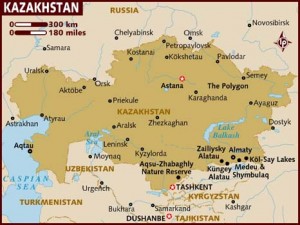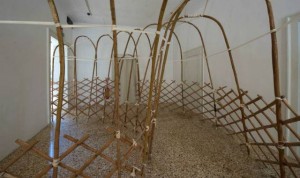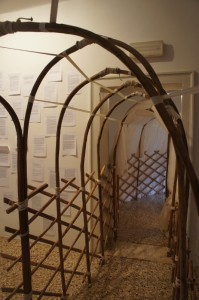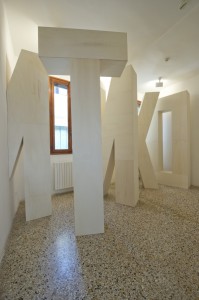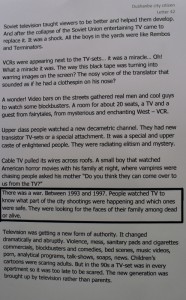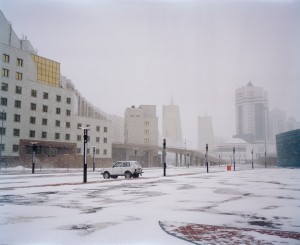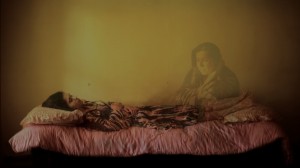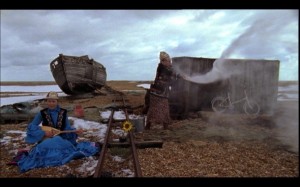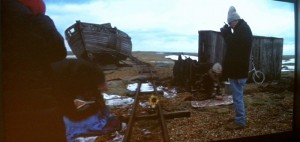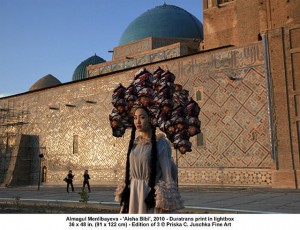East of the Caspian Sea Central Asia in Venice
Have you heard of Abay Qunanbayuli? He is a nineteenth century poet from Kazakhstan who wrote at the cusp of the modern era, and is regarded as the intellectual foundation for the country. 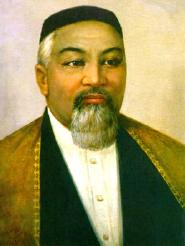 Winter is one of his most famous poems as well as the theme of the Central Asian Pavilion at the Venice Biennale. His poem is full of frozen, cold references about the difficulty of survival in the midst of bitter cold. That metaphor is central to the pavilion. Tiago Bom (Portugal) and Ayatgali Tuleubek (Kazakhstan), two young curators based in Oslo, Norway, explore the theme of “stagnation.”
Winter is one of his most famous poems as well as the theme of the Central Asian Pavilion at the Venice Biennale. His poem is full of frozen, cold references about the difficulty of survival in the midst of bitter cold. That metaphor is central to the pavilion. Tiago Bom (Portugal) and Ayatgali Tuleubek (Kazakhstan), two young curators based in Oslo, Norway, explore the theme of “stagnation.”
Winter
Broad-shouldered, white-coated, powdered with snow,
Blind and dumb, with a great big silvery beard,
Granddad Winter plods on with a frown on his brow,
By everything living hated and feared.
The grumpy old fellow does plenty of harm.
His breath stirs up blizzards, brings snow and cold.
With a cloud for a hat on his shaggy head,
He marches along, all the world in his hold.
His beetling eyebrows are knit in a frown.
When he tosses his head—dismal snow starts to fall.
Like a crazy old camel he acts in his rage,
Rocking and shaking our yurt’s thin wall.
If the children run out to play in the yard
He pinches their noses and checks with cruel hands.
No sheepskin can keep out the freezing cold;
With his back lo the wind, the shepherd stands.
The horses in vain try to shatter the ice—
The hungry herd scarcely shuffle their feet.
Greedy wolves—winter’s henchmen—bare their fangs;
Watch, or disaster your flocks may meet!
Drive them off to safe pastures—don’t wait until day.
You won’t die if you sleep less—come, quicken your step.
Kondibai and Kondai aren’t as wicked as wolves—
Don’t let old man Winter feast in our steppes.
Abay Qunanbayuli, 1888
Translated by Dorian Rottenberg
For those of you who are weak on the geography in this part of the world, Central Asia is East of the Caspian Sea, and includes several former Soviet countries: Kazakhstan ( the largest), Uzbekistan, Tajikstan and Kyrgyzstan. (also Turkmenistan not included in the exhibition).
I have to add here a phenomenal article just published in Z magazine and available online from Allen Ruff’s blogspot that gives us the US history with these nations since their “independence” from Russia. We have been pouring untold amounts of money into these countries, all of them with horrific human rights histories.. The enormous economic bonanza of the “war on terror” in Afghanistan going to leaders in the”stans” who are siphoning billions off for their personal benefit, as they practice all the abuses we are supposedly resisting and fighting against, certainly must form the “frozen winter” of this discussion of a courageous effort on the part of creative young people from Central Asia who are exploring ways of moving beyond repression. Their power is small, compared to these large economic forces, but they represent a pinpoint of hope and light. Unfreezing minds that live in fear is the first step to freedom.
The intellectual theme of the pavilion is not apparent in a walk through where we first saw an altered yurt (traditional nomadic home) Zhol (The Way, 2013) by Kamilla Kurmanbekova and Erlan Tuyakov, a wooden structure that was a comment on the government’s appropriation of it for the idea of nationalism. Rather than the sturdy structures of traditional yurts, there was an unstable quality in this slender construction, certainly a metaphor for the state of nomads as well as the perceptions of outsiders.
There were large white letters by Vyacheslav Akhunov that looked like minimalist sculptures but turned out to be Cyrillic characters referring to a public monument that was censored in the 1970s;
Letters from Tajikistan (2013) Anton Rodin and Sergey Chutkov presenting “patterns of dissent and affinity;” In this letter the changing and insidious role of television since independence is described.
Ikuru Kuwajima’s color photographs of a desolate urban environment which were taken in Northern Kazakhstan where the government has built a new capitol in a frigid environment,
Zukhra by Saodat Ismailova which draws on mythology and childhood
memories
Aza Shade’s The Disappearing City. Shade explores, with an edge of the absurd, the distance of young people from traditional culture: the mother of a young woman insists that she pose with traditional clothes playing a traditional instrument for tourists, but then the daughter changes into contemporary clothes and walks off.
But the pavilion was a layered event, with forums, films, and an online catalog coming in June. Its intellectual depth emerged only slowly, a bit like the process of unfreezing. Once I read the poem several times, as well as the other materials, it was clear that the organizers were deeply committed to thinking about the position of culture within a hostile (frozen) environment, the situation both literally and metaphorically in Kazakhstan in particular.
That country has had the same Soviet era Communist leader since independence. There were photographs online of intense conversations held in the pavilion courtyard during the opening and in the first week of October. To better grasp the extent of the pavilion, which reaches to Oslo, as well as to Almaty, Kazakhstan, go on line and view lectures such as that by the extraordinary Kazakh filmmaker, Almagul Menlibayeva.
I had the good fortune of seeing two of her films at the Asian Art Museum in Seattle last year, thanks to our wonderful curator Pamela McClusky. Menlibayeva grew up in the last years of the Soviet Union and was educated as it crumbled. Before capitalism invaded the country, she spent five years in a young artists collective. She dramatically conveys a desolate and surreal atmosphere of mythic history, empty modernism, and nomadic transformations in her films which convey “her own nomadic heritage with spiritual residues of traditional belief systems” as McClusky puts it.
The Central Asian Pavilion was much more than the sum of its parts. I am looking forward to the publication of its catalog in the spring which will give us more texts. The organizers of “Winter” sought to invite conversations about culture in Central Aisa,to stimulate new directions within the parameters of the difficult political and environmental conditions of the countries of Central Asia.
This entry was posted on December 12, 2013 and is filed under Art and Politics Now, art criticism, Contemporary Art, Uncategorized, Women Artists.


